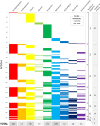Trends and gaps in precision health research: a scoping review
- PMID: 34697128
- PMCID: PMC8547511
- DOI: 10.1136/bmjopen-2021-056938
Trends and gaps in precision health research: a scoping review
Abstract
Objective: To determine progress and gaps in global precision health research, examining whether precision health studies integrate multiple types of information for health promotion or restoration.
Design: Scoping review.
Data sources: Searches in Medline (OVID), PsycINFO (OVID), Embase, Scopus, Web of Science and grey literature (Google Scholar) were carried out in June 2020.
Eligibility criteria: Studies should describe original precision health research; involve human participants, datasets or samples; and collect health-related information. Reviews, editorial articles, conference abstracts or posters, dissertations and articles not published in English were excluded.
Data extraction and synthesis: The following data were extracted in independent duplicate: author details, study objectives, technology developed, study design, health conditions addressed, precision health focus, data collected for personalisation, participant characteristics and sentence defining 'precision health'. Quantitative and qualitative data were summarised narratively in text and presented in tables and graphs.
Results: After screening 8053 articles, 225 studies were reviewed. Almost half (105/225, 46.7%) of the studies focused on developing an intervention, primarily digital health promotion tools (80/225, 35.6%). Only 28.9% (65/225) of the studies used at least four types of participant data for tailoring, with personalisation usually based on behavioural (108/225, 48%), sociodemographic (100/225, 44.4%) and/or clinical (98/225, 43.6%) information. Participant median age was 48 years old (IQR 28-61), and the top three health conditions addressed were metabolic disorders (35/225, 15.6%), cardiovascular disease (29/225, 12.9%) and cancer (26/225, 11.6%). Only 68% of the studies (153/225) reported participants' gender, 38.7% (87/225) provided participants' race/ethnicity, and 20.4% (46/225) included people from socioeconomically disadvantaged backgrounds. More than 57% of the articles (130/225) have authors from only one discipline.
Conclusions: Although there is a growing number of precision health studies that test or develop interventions, there is a significant gap in the integration of multiple data types, systematic intervention assessment using randomised controlled trials and reporting of participant gender and ethnicity. Greater interdisciplinary collaboration is needed to gather multiple data types; collectively analyse big and complex data; and provide interventions that restore, maintain and/or promote good health for all, from birth to old age.
Keywords: general medicine (see internal medicine); nutrition & dietetics; occupational & industrial medicine; preventive medicine; public health; social medicine.
© Author(s) (or their employer(s)) 2021. Re-use permitted under CC BY-NC. No commercial re-use. See rights and permissions. Published by BMJ.
Conflict of interest statement
Competing interests: None declared.
Figures



References
Publication types
MeSH terms
LinkOut - more resources
Full Text Sources
Miscellaneous
